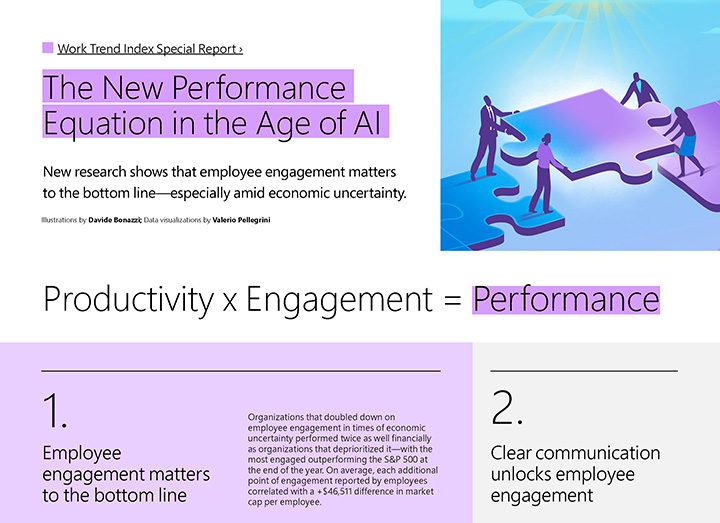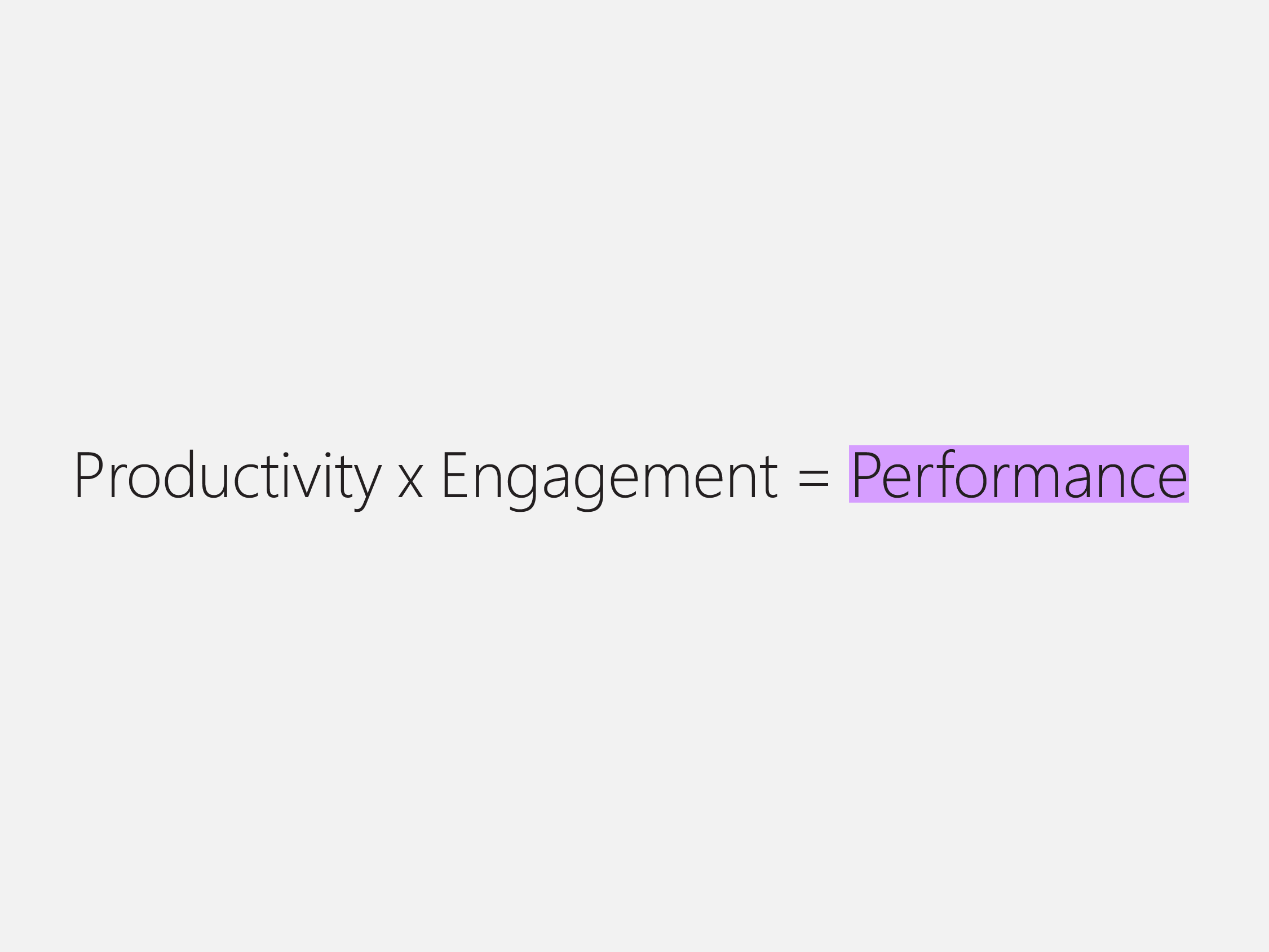
Download the one pager

The New Performance Equation in the Age of AI
Amid economic uncertainty and the transition to flexible work, leaders are under pressure to increase productivity in flexible work and do more with less. At the same time, next-generation AI is changing the game for how organizations gain a competitive advantage. In this dynamic environment, employee engagement may not seem like a priority. New research tells a different story.
To help understand the ongoing business impact of engagement—and what drives it—we analyzed surveys of more than three million employees at more than 200 companies across industries and looked at the combined stock price movement of these companies throughout 2022.
The findings are clear. High employee engagement correlates with stronger financial performance. And companies with highly engaged employees focus on two things: they create clarity via intentional employee communications and goal setting, and they use data to build a powerful “feedback flywheel” to continuously improve over time.
Companies with highly engaged workforces had better financial outcomes, outperforming the S&P 500 after a year.
The analysis shows that employee engagement is a key part of the performance equation. To move the bottom line, we need more than productivity alone. Think of engagement and productivity as mutually reinforcing, with one multiplying the other: When you are engaged in your work, you are more productive. When you are productive, you are more engaged in your work.
Let’s take a closer look.
Three key findings:
Employee engagement matters to the bottom line—especially amid economic uncertainty.
Clear communications and goals unlock employee engagement.
To sustain engagement, build a feedback flywheel.
The new performance equation
Both engagement and productivity drive performance—and they are mutually reinforcing

1. Employee engagement matters to the bottom line—especially amid economic uncertainty.
Research shows that organizations that doubled down on employee engagement in times of economic uncertainty performed twice as well financially as organizations that deprioritized it—with the most engaged outperforming the S&P 500 at the end of the year. On average, each additional point of engagement reported by employees correlated with a +$46,511 difference in market cap per employee. Put simply, companies with highly engaged workforces had better financial outcomes. Leaders need to treat employee engagement with the same strategic importance as business and financial outcomes.
Engagement Is Critical to Your Bottom Line
A comparison of 2022 financial portfolio returns of the top 10% highest engagement scoring companies against the bottom 10% lowest engagement scoring companies shows that highly engaged companies outperformed the least engaged companies.
Engagement levels determined by employee survey responses from over three million employees, collected from January 1, 2022 to December 31, 2022, which were analyzed for employee sentiment.
Illustration by Valerio Pellegrini
Take action:
Measure and report on employee engagement as you do financial metrics—in town halls, at board meetings, and in annual reports.
Adopt an organization-wide manager framework that helps leaders develop skills and adopt a growth mindset around engagement.
Communicate that engagement is a business imperative—for instance, by creating an engagement-related goal for managers.
Give managers access to data to help them take action on improving communication, employee engagement, and productivity.
Adopt a digital employee experience that leverages next-generation AI and data-driven insights.
2. Clear communication and goals unlock employee engagement.
In a more distributed, flexible work world, managers and leaders lack the skills and tools to communicate, mobilize, and engage people effectively—and those skills and tools are more critical than ever. At the least engaged organizations, nearly one in four employees are not sure what they should focus on. On the flip side, employees at highly engaged organizations are 46 percent more likely to see their organizations as strong communicators, 37 percent more likely to express confidence in leadership, and 16 percent more likely to be clear on what to focus on than the least engaged organizations. Clear communication also has an impact on retention. Employees who report that their company does a bad job of communicating are twice as likely to leave their organization compared with employees who cite good communication.
To respond, leaders need to provide intentional communication that meets people where they are—in the flow of work. As our data has shown previously, clarity is key. Without it, employees face challenges in prioritizing work and they lose sight of why their work matters.
“Employees at highly engaged organizations are 46% more likely to see their organizations as strong communicators.”
Take action:
Create clear priorities at the leadership level and use goals like OKRs to help everyone focus on those priorities.
Equip leaders with modern communication tools that meet employees where they are in the flow of work.
Use next-generation AI and data-driven analytics to increase the effectiveness of communications.
3. To sustain engagement, build a feedback flywheel.
To build and sustain engagement, leaders need agile and ongoing systems for gathering and responding to employee feedback and driving change. Employees at highly engaged organizations are 40 percent more likely to have confidence that their feedback will lead to action, and they’re 56 percent more likely to say their organizations continually improve processes. Diversity of opinion matters—a key differentiator between organizations with high and low engagement is whether employees feel that diverse perspectives are valued.
On their own, traditional linear feedback systems are no longer enough to get a pulse on how employees are doing and improve organizational processes over time. The key is to combine employee feedback with behavioral data from productivity and collaboration signals and sentiment in communities to build a “feedback flywheel”—a continuous loop in which this rich combination of data is gathered, analyzed, and turned into actions that get communicated back to employees and implemented across the organization.
Take action:
Make sure your listening strategy is comprehensive—incorporate relevant direct and indirect signals.
Leverage AI to analyze the data collected, gain a more thorough understanding of patterns, and accelerate time to action.
Empower managers to create their own feedback flywheels to drive meaningful change within their teams, and ensure key metrics are in place to measure impact.
Set accountability measures that help employees trust that action will be taken. Be transparent about how feedback will be used, and provide clear next steps.
The way forward
This latest research shows definitively what many leaders know intuitively: a workforce that is energized and empowered is more likely to be productive and high performing. As next-generation AI begins to change the talent landscape and re-engineer skilling for the workforce, the winners in both the financial and labor markets will be the organizations that take critical action now.
Stock Price Analysis
The research was conducted by the Viva People Science team at Viva Glint, a “voice of the employee” solution helping organizations understand and improve employee engagement to drive business outcomes. It draws from employee survey responses from more than 3 million employees, collected from January 1, 2022 to December 31, 2022, by 226 public organizations listed on U.S. stock exchanges, which were analyzed for employee sentiment. Public year-start and month-end stock price data spanning January through December of 2022 was collated for these same 226 organizations. These organizations, while publicly listed on U.S. exchanges, were composed of employees distributed around the globe and spanned 17 industries, including: Manufacturing, Technology, Finance, Professional Services, Food and Beverages, Utilities, Oil, Gas, & Mining, Pharmaceuticals, Insurance, Retail, Healthcare, Transportation & Logistics, Travel, Hospitality, & Leisure, Media, Construction, Biotechnology, and Real Estate.
The survey data set was used to group organizations with the most (top 10%) and least (bottom 10%) engaged workforces, as measured by Viva Glint’s eSat survey item. Using the stock price data set, the combined stock price movement of these high- and low-engagement groups was tracked for the 2022 calendar year, and the year-end total stock return for each group was calculated.
Employee Experience Analysis
The analysis used survey responses from more than 9 million employees, collected from January 1, 2022 to December 31, 2022 by 1,009 organizations. The survey data set was used to group organizations with high- and low-engaged workforces (by isolating the top and bottom third based on engagement score), as measured by Viva Glint’s eSat survey item. For each facet of employee sentiment (e.g., clarity about priorities, confidence in company future), mean percent favorable scores (defined as the mean % of respondents selecting the top two points on five- and seven-point response scales) were calculated for both the high- and low-engaged organization groups.

